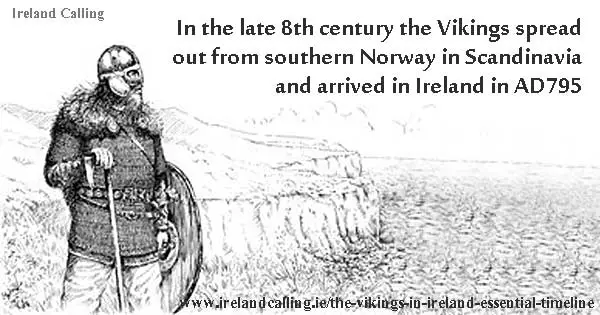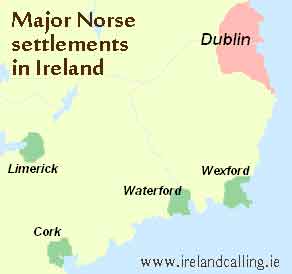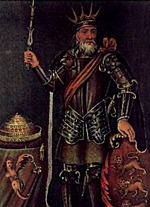The Vikings played a key role in Irish history. Even though they first arrived over 1,200 years ago, they helped to shape the country as we know it today. This is a timeline of the key events of the Viking era of Irish history.
AD 795 – The Norse Vikings from modern-day Norway arrive in Ireland for the first time and land in Dublin Bay. They violently attacked the monastery on Lambay Island, and sailed away with all the treasure they could carry.
795 – 841 – The Vikings continued to return to Ireland in a series of smash and grab raids on the country’s monasteries.
841 – By 841 the Vikings had set up a settlement on the banks of the River Liffey. This was originally designed for them to stay over the winter. However, the settlement eventually became a town which grew to be the modern day Dublin.
841 – 900 – The Vikings set up numerous settlements along the coast which would go on to become some of the country’s major cities – Dublin, Cork, Limerick, Waterford and Wexford.
The settlements grew to become important trading centres and had links to other settlements in the north of England and the Isle of Man. The Vikings were unable to establish any major stronghold in Ulster due to the power of the Uí Néill, who ruled the north and were strong enough to withstand any attempted invasion.
851 – The Danish Vikings arrived in Ireland and attacked the Norse Vikings. Over the years the Vikings would have rivalries with other Vikings as much as with the Irish. Likewise, the Irish kings and chieftains would be happy to form alliances with Vikings in order to defeat another Irish clan.
902 – Irish clans defeat the Vikings in Dublin and force them out of the town. The Vikings flee to Britain. While in Britain, the Dublin Vikings saw that the towns were more advanced than the one they had built in Dublin. They became aware of greater possibilities.
917 – The Vikings returned to seize control of Dublin. They put what they learnt in the British towns into practice and before long had built a stockade around the town to protect the residents from attacks from outside the walls.
936 – After years of conflict between the Vikings and the Irish, the Irish burned Dublin to the ground. However the Vikings were more resilient than they had been in 902 and quickly rebuilt the town.
976 – Brian Boru becomes king of the Dál gCais, a small kingdom in the south west of Ireland.
977 – Brian gains his first victory over the Vikings as the Dál gCais seized control of Limerick.
978 – Brian becomes King of Munster as the Dál gCais defeat the once mighty Eóganachta.
980 – On the other side of the country, the Vikings temporarily lose control of Dublin as King Máel Seachnaill of the Uí Néill captures the city.
980 – The Vikings reclaim Dublin as King Máel turns his attention to the threat posed by Brian and the Dál gCais from the south.
997 – After 17 years of power struggles between the Uí Néill and the Dál gCais, kings Máel Seachnaill and Brian Boru come to an agreement that Máel would be King of the North of Ireland and Brian would be King of the South.
999 – Brian breaks the agreement and defeats a coalition of the Uí Néill forces and Dublin Vikings.
1001 – King Máel is abandoned by his allies, including the northern branch of the Uí Néill, and has no choice but to submit to Brian.
1001 – 1011 – King Brian continues to expand his territory and becomes Ireland’s last ever High King. With the whole country under one ruler, it was, for a brief period, at peace. However, Brian had made many enemies, who were biding their time to reclaim their territories.
1013 – King of Leinster Máel Mórda visited Brian to pay homage. Mórda became furious after being insulted by Brian’s son and left without saying a word. Brian sent a messenger to bring Mórda back to the palace. However, Mórda killed the messenger, an act that left both Kings with nowhere to go but to war.
1013 – Mórda and Brian recruit allies and assemble their armies. Mórda is able to outbid Brian for the support of Sitric Silkenbeard, King of the Dublin Vikings. Silkenbeard recruits Viking forces from all over Britain and the Isle of Man. Brian’s forces included his allies in the Munster and Connacht provinces.
1014 – The Battle of Clontarf took place on Good Friday 23 April. The armies of Brian Boru and Máel Mórda took place in the battle that would change the power structure of the country. The battle lasted from sunrise until sunset and between 7,000 and 10,000 men were killed. Mórda, Brian and Brian’s son and grandson were among the casualties.
1014 – 1036 – Sitric Silkenbeard remains King of Dublin until his death. However, the Vikings power in Ireland was significantly reduced after losing such a significant battle.
1036 – 1042 – The Vikings remain in control of Dublin. However, over the decades they became ever more integrated with the Irish and eventually took Christianity as their religion.
More Irish history articles
Brian Boru – High King of Ireland who took on the Vikings



